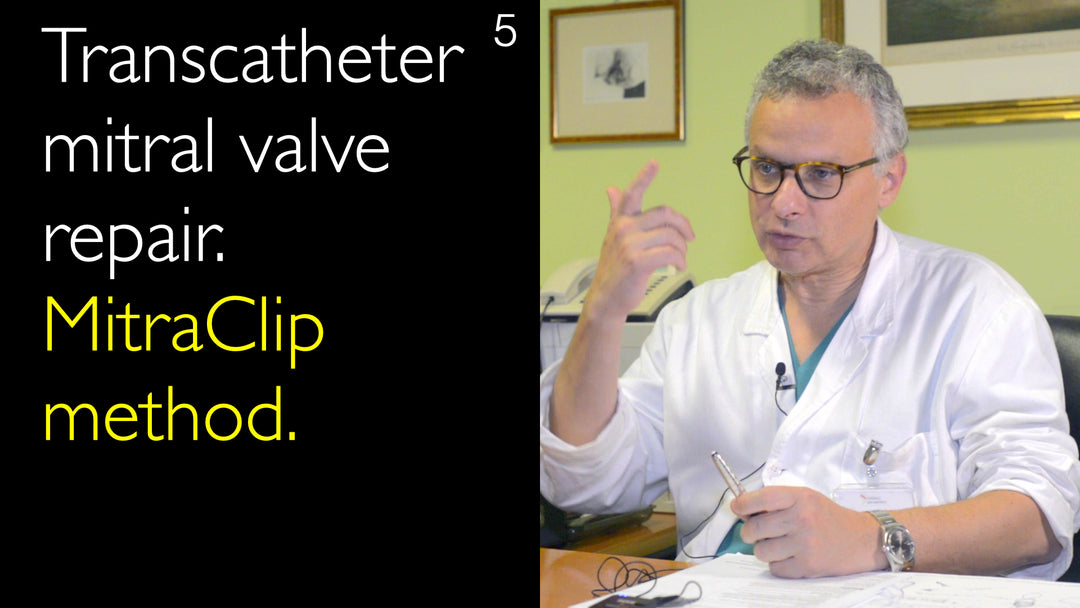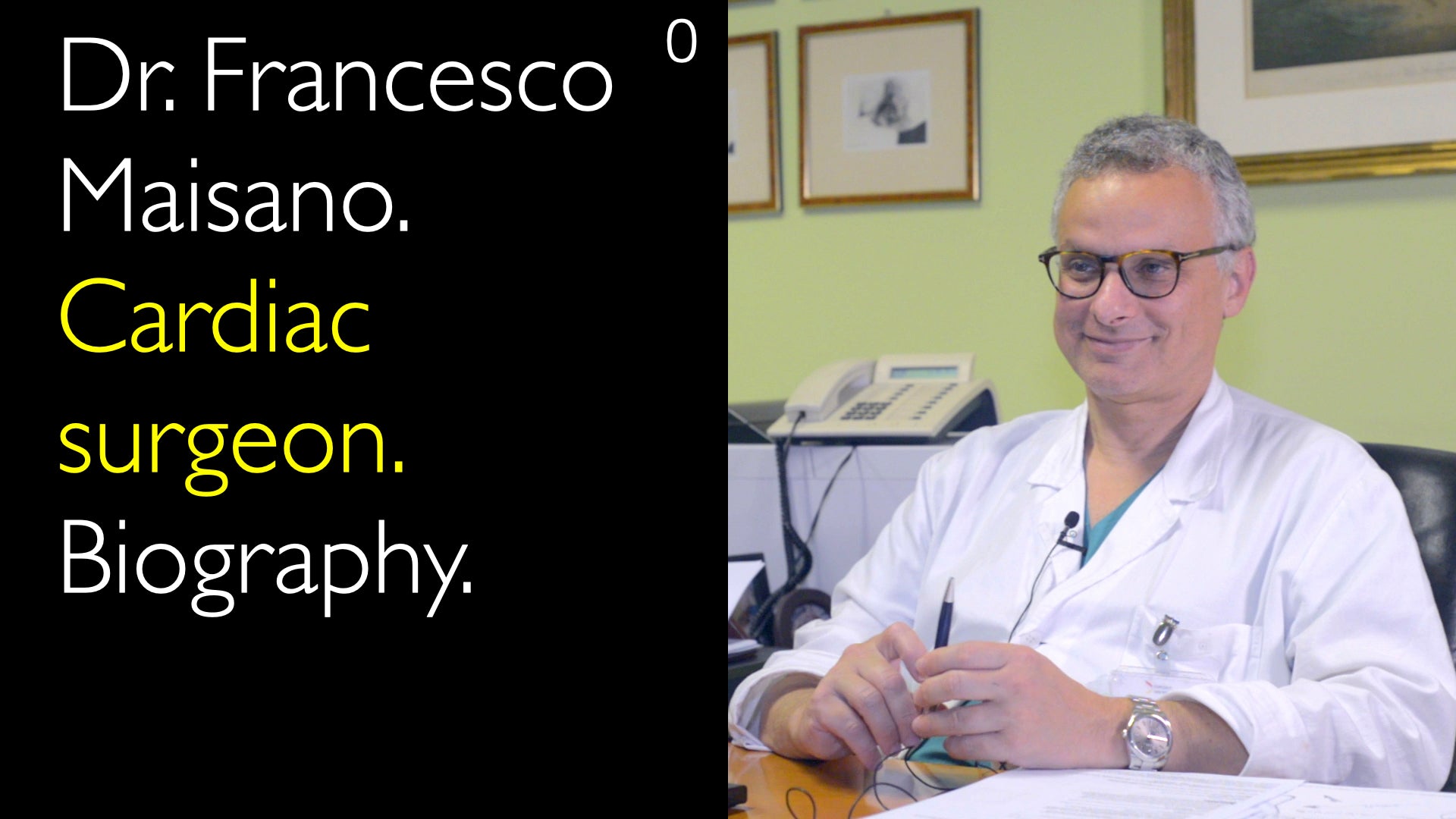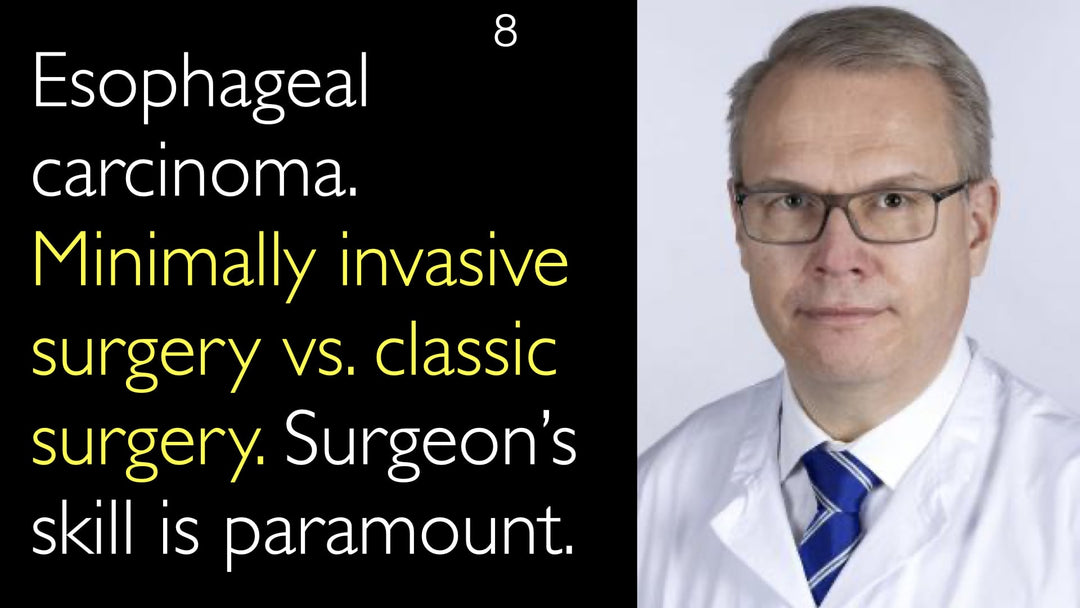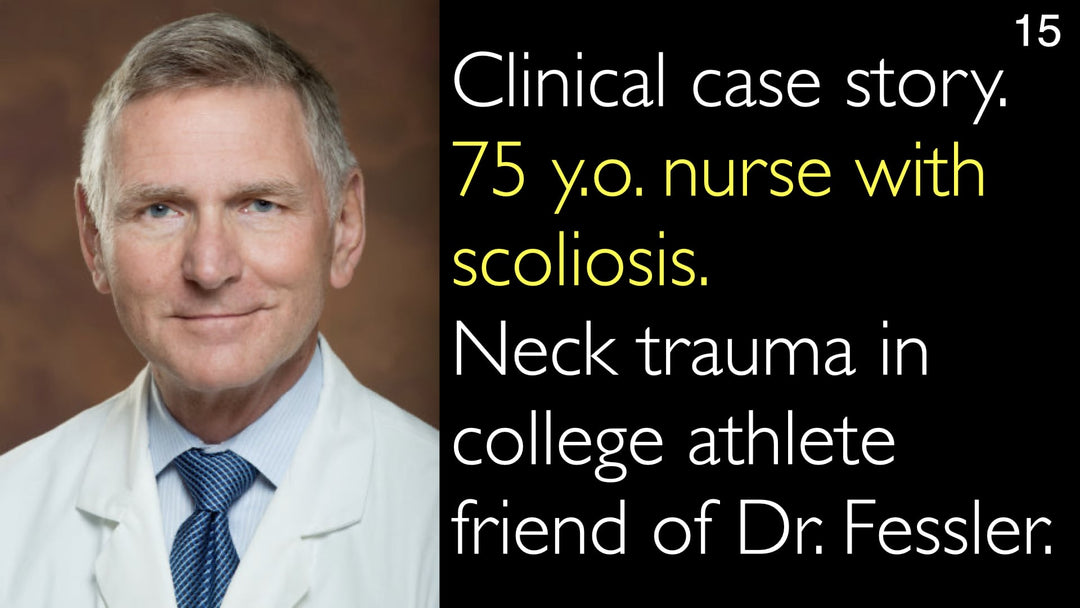Leading expert in transcatheter mitral valve repair, Dr. Francesco Maisano, MD, explains the MitraClip procedure. This minimally invasive technique treats mitral regurgitation. Dr. Maisano details how the device replicates a surgical method. He compares MitraClip to percutaneous annuloplasty. Dr. Francesco Maisano, MD, outlines the advantages and current limitations of each approach for different patient profiles.
Transcatheter Mitral Valve Repair: The MitraClip Procedure and Annuloplasty Options
Jump To Section
- What is the MitraClip Procedure?
- How the MitraClip System Works
- Advantages Over Open-Heart Surgery
- The Role of Percutaneous Annuloplasty
- Comparing MitraClip and Annuloplasty Techniques
- Future Directions in Mitral Valve Repair
- Full Transcript
What is the MitraClip Procedure?
Transcatheter mitral valve repair offers a minimally invasive alternative to open-heart surgery for mitral regurgitation. Dr. Francesco Maisano, MD, describes the MitraClip as a device designed to perform a transcatheter edge-to-edge repair (TEER). This technique reproduces the surgical Alfieri method, which involves approximating the two leaflets of the mitral valve.
The procedure is versatile. It effectively treats both degenerative mitral valve prolapse and functional mitral regurgitation. By joining the leaflets together with a clip, the procedure forces coaptation at the site of the leak, eliminating regurgitation.
How the MitraClip System Works
The MitraClip device is essentially a clamp introduced into the body percutaneously. Dr. Francesco Maisano, MD, explains that the procedure is performed under general anesthesia with fluoroscopic and transesophageal echocardiography guidance. The interventional team crosses the atrial septum to access the left atrium and positions the device in front of the mitral valve.
The MitraClip's two arms are opened inside the valve. The device then clamps the target leaflets together, joining them. A key benefit is the ability to perform this entire process on a beating heart, allowing for real-time assessment of the repair's hemodynamic effect before final deployment.
Advantages Over Open-Heart Surgery
MitraClip transcatheter mitral valve repair provides significant advantages compared to traditional surgery. Dr. Francesco Maisano, MD, highlights the "online" nature of the procedure. Surgeons operate on a non-beating heart during open surgery and must predict the repair's outcome. In contrast, the MitraClip procedure provides immediate visual and hemodynamic feedback.
This real-time guidance allows the operator to adapt the intervention to the patient's specific anatomy. If the initial clip placement does not yield an optimal result, the device can be released and repositioned. This dynamic, physiology-driven approach can lead to more precise and effective repairs for complex mitral valve pathology.
The Role of Percutaneous Annuloplasty
Percutaneous annuloplasty addresses a different component of mitral valve disease. Dr. Francesco Maisano, MD, notes that a dilated mitral valve annulus is a common finding in regurgitation. This dilation creates a mismatch between the annulus size and the leaflet tissue, preventing proper coaptation and causing leakage.
Annuloplasty devices aim to reduce the size of the annulus, re-establishing a normal anatomical balance. This reduction also decreases stress on the valve apparatus. Dr. Maisano believes annuloplasty holds great promise, particularly for patients in the early stages of functional mitral regurgitation before severe ventricular remodeling occurs.
Comparing MitraClip and Annuloplasty Techniques
Choosing between MitraClip and annuloplasty depends on patient factors and procedural considerations. Dr. Anton Titov, MD, and Dr. Francesco Maisano, MD, discuss the critical differences. MitraClip is a versatile, widely available solution that can often be performed immediately without extensive pre-procedural planning.
Percutaneous annuloplasty is currently more complex. It often requires pre-procedural cardiac CT planning and is associated with a higher risk of adverse events, such as coronary artery injury, with first-generation devices. However, annuloplasty leaves no implant in the valve orifice, preserving future treatment options like valve replacement, which is a significant long-term advantage.
Future Directions in Mitral Valve Repair
The field of transcatheter mitral valve intervention is rapidly evolving. Dr. Francesco Maisano, MD, anticipates that second-generation annuloplasty devices will be more operator-friendly and safer. This advancement could establish annuloplasty as a leading solution for early-stage disease.
Future applications may expand to include treating functional regurgitation in both the mitral and tricuspid valves, especially in patients with atrial dilation. The combination of techniques, such as annuloplasty followed by a clip or valve replacement, represents a holistic, patient-tailored approach to managing complex valvular heart disease without open surgery.
Full Transcript
Dr. Anton Titov, MD: Mitral valve prolapse is often treated with open-heart surgery. But recently, minimally invasive percutaneous transcatheter mitral valve repair methods also appeared. It is a very promising therapy for mitral valve regurgitation. Your team, together with Professor Ottavio Alfieri, developed a particular percutaneous method of mitral valve repair. It's called MitraClip. What is MitraClip and how to use MitraClip in the minimally invasive treatment of mitral valve prolapse?
Dr. Francesco Maisano, MD: First of all, a MitraClip is designed to reproduce the so-called Alfieri technique. Today, we should talk about transcatheter edge-to-edge repair, or TEER. This is the name that is in the treatment guidelines today because transcatheter edge-to-edge repair can be done during the same operation with different technologies.
MitraClip is one method, which has been mostly used today. Pascal is a similar device for transcatheter mitral valve repair, making the same approach. It's the approximation of two leaflets of the mitral valve. One mitral valve leaflet is moving too much or too little, so either it's a prolapse or it is a tethering.
You can put the two leaflets together, join them with one device, which is a clip, a clasp, or whatever. Then you try to put the two valvular leaflets together. In this way, you obtain the coaptation of mitral valve leaflets. You force the coaptation at the site of the mitral valve regurgitation. This is the concept of the Alfieri technique of mitral valve repair.
The Alfieri technique has a huge advantage over any other techniques of mitral valve repair. Alfieri's edge-to-edge valve repair method is so versatile. It can be used in mitral valve prolapse. It can be used in functional mitral regurgitation. It doesn't matter what happens below the mitral valve. The valvular leaflets are joined together, and this creates the solution.
MitraClip was developed in the early 2000s. It was developed during the late 1990s. They started the evolution of the development of this technology. It is, basically, a clamp. It is a clamp that clamps the two valvular leaflets together.
The clamp is introduced into the body under fluoroscopic and echocardiography guidance. The patient will be in general anesthesia with transesophageal echocardiography. It will be producing the images that we will use for the implantation of the MitraClip. We cross the septum. We get into the left atrium. We go in front of the mitral valve, we open the MitraClip clamp.
The MitraClip is basically made of two arms, which are opened with this device. It goes into the inside of the mitral valve, it clamps the leaflets. The MitraClip is closed, the leaflets are approximated, and they are joined together. All this is done under physiologic conditions. And that's the beauty of it.
Compared to open-heart surgery, where we operate on a non-beating heart, we can do things that are fantastic, but we need to be very smart. We need to predict how this anatomy will react to beating heart conditions. So we cannot see the effect of our intervention until we close the heart and wean the patient from a cardiopulmonary bypass machine.
In MitraClip, it's all done on a beating heart, online. What you do is what you get. You see immediately the effect of your action. And you can adapt MitraClip to the patient's condition and patient's anatomy. If you don't like the effect, you can release the MitraClip clamp and start in another position. You are guided during these decisions by the hemodynamic effects of your MitraClip implantation.
To some extent, it is a simplification of surgery. To some extent, it is even more than surgery. It is a very hemodynamically-driven intervention. That also requires quite a lot of experience to make the right decisions during MitraClip transcatheter mitral valve repair.
Dr. Anton Titov, MD: Also, there is an opportunity to do MitraClip. But there is another technique called percutaneous annuloplasty. What are the advantages and disadvantages of MitraClip and percutaneous annuloplasty? How do you compare these techniques and apply them to the right patient with mitral regurgitation?
Dr. Francesco Maisano, MD: Annuloplasty. I have been developing one of the tools to reduce the size of the annulus of mitral valve. First of all, annuloplasty is a surgical technique that is done in every mitral valve repair in open surgery or minimally invasive surgery. So it is very commonly done.
The reason is that the annulus, which is basically connected at the base of the heart, is found dilated in almost every patient with mitral valve regurgitation. For this reason, there is a need to reduce the size of the mitral valve annulus because there is a mismatch between the size of the valvular annulus and the size of the valve leaflets.
The annulus is so dilated that the leaflets cannot touch each other anymore in the middle. This has two consequences. One consequence is mitral valve regurgitation. They don't touch. The second consequence is that there is a lot of stress on this difference.
Even if you join them, let's say with the MitraClip, you can create a lot of tension there. Eventually, you may break or you may damage the valvular leaflets. This also happens in surgery. If you do a procedure without annuloplasty, the tension remains there. And you can have a tear of your reconstruction of the mitral valve.
For this reason, by using the annuloplasty, you bring the leaflets together, you re-establish a good balance between the size of the annulus and the size of the mitral valve leaflets. And then you reduce the stress on the system. So, annuloplasty, in principle, could be done in most of the functional mitral regurgitation patients.
Specifically, it can be done in the early stages before the ventricle becomes very dilated. Because in the early mitral valve regurgitation phase, the mitral valve leaflets are still not too much pulled down into the left ventricle. I still believe that in the future, annuloplasty could become the leading solution for those patients undergoing procedures early in their disease stage.
The other advantage of annuloplasty is that it gives a very little footprint. In MitraClip, or any clip-in device will stay in the middle of the heart valve. This will be creating anatomy which may prevent other treatment options like mitral valve replacement. We already have solutions for that, but in principle, it makes things more difficult.
An annuloplasty is only a reduction and normalization of the annulus. So basically, you can do anything after that. You can put a clip. You can put a valve replacement. We have already done many cases. So, these are the advantages.
The main disadvantage of transcatheter annuloplasty today is the complexity of the procedure. The imaging is not ideal enough for these procedures. The transcatheter annuloplasty devices are still in the first generation. The second generation has not yet arrived.
As soon as we have the second generation, probably they will become more operator-friendly and therefore also safer. At the moment, because of the difficulty of imaging, because of the difficulty of the handling of transcatheter annuloplasty, there are still too many adverse events.
We have too many cases of coronary artery injury. We have too many cases of insufficient implantation of the annuloplasty device. We also have some cases of suboptimal outcomes. So transcatheter annuloplasty is not yet the solution for every patient.
And then the other limitation of annuloplasty today is this. If a patient comes to the hospital as an emergency, and if I need to do something now, I can do a MitraClip procedure immediately. I don't need any preprocedural planning. Transcatheter annuloplasty needs, at this moment, cardiac CT scan planning before the intervention.
So the availability of annuloplasty is another limitation. This is similar for annuloplasty and for mitral valve replacement. But again, in the future, I will not be surprised if annuloplasty becomes more and more utilized in the atriogenic forms.
First of all, there are many patients with normal left ventricle and large atria. And this can be used both in the mitral valve and in the tricuspid valve. Annuloplasty can also be used in functional mitral regurgitation or tricuspid regurgitation in patients in the early stages of mitral valve prolapse, where there is not much tethering of valvular leaflets.








